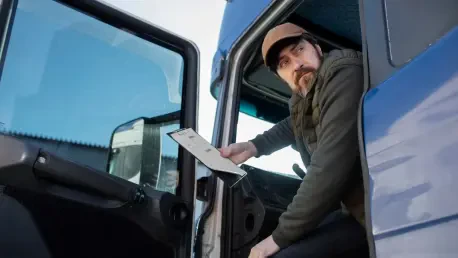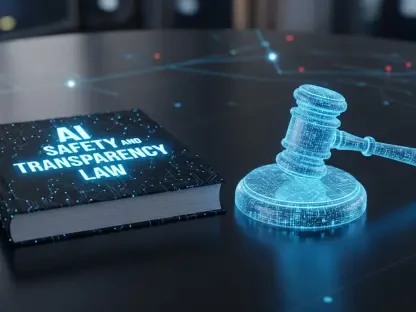Imagine a sprawling network of highways across the United States, where over 3.5 million truck drivers transport goods critical to daily life, only for a series of tragic accidents to reveal hidden flaws in who gets behind the wheel of these massive vehicles. The U.S. Department of Transportation (DOT) has responded with a sweeping regulatory overhaul targeting non-citizen truck drivers, aiming to address safety concerns tied to improperly issued commercial driver’s licenses (CDLs). This report delves into the state of the trucking industry, the rationale behind the tightened rules, and the far-reaching implications for drivers, states, and the supply chain. With road safety now at the forefront of federal policy, understanding these changes is essential for stakeholders navigating this evolving landscape.
Overview of the Trucking Industry and Non-Citizen Drivers
The U.S. trucking industry serves as the backbone of the economy, moving approximately 72% of the nation’s freight by weight and generating over $700 billion in annual revenue. This sector employs millions and ensures the timely delivery of everything from food to industrial materials, making it indispensable to the supply chain. Amid rising demand for goods, the industry faces persistent challenges, including driver shortages and increasing scrutiny over safety standards, which have brought regulatory oversight into sharp focus.
Non-citizen drivers play a notable role in this workforce, with estimates suggesting around 200,000 hold CDLs, representing roughly 5% of the total licensed truck drivers. Their participation helps address labor gaps, particularly in regions with high demand for transport services. However, concerns about vetting processes and compliance with federal guidelines have prompted a reevaluation of their eligibility to operate commercial vehicles on American roads.
Key regulatory bodies, such as the DOT and the Federal Motor Carrier Safety Administration (FMCSA), oversee licensing and safety protocols for the industry. Existing frameworks require states to issue CDLs based on federal standards, including residency verification and English proficiency tests. Despite these measures, inconsistencies in enforcement have exposed vulnerabilities, setting the stage for the latest policy changes aimed at tightening control over who can drive.
Background and Rationale for New Regulations
Safety Concerns Driving Policy Changes
Recent years have seen a troubling pattern of fatal accidents involving non-citizen truck drivers, prompting the DOT to prioritize road safety through stricter regulations. These incidents have raised alarms about inadequate training, language barriers, and questionable licensing practices, with federal authorities pointing to a clear need for reform. Public outcry over preventable tragedies has further fueled demands for accountability, pushing policymakers to act decisively.
A prominent case that galvanized this shift involved Harjinder Singh, a 28-year-old driver charged in a devastating crash on the Florida Turnpike in Fort Pierce, which claimed three lives. Singh, who obtained a CDL in California despite failing English proficiency requirements and lacking proper residency documentation, became a symbol of systemic failures. This incident, among others, underscored the urgency of addressing gaps in oversight and enforcement.
Federal oversight trends now lean heavily toward zero-tolerance policies, with the DOT emphasizing that operating an 80,000-pound vehicle is a privilege requiring rigorous vetting. Statements from Transportation Secretary Sean Duffy highlight a commitment to protecting American families by ensuring only qualified individuals hold CDLs. This stance reflects a broader push for safety that transcends political divides, driven by hard evidence of risk on the nation’s highways.
Evidence of Systemic Issues in Licensing
A national audit conducted by the FMCSA revealed glaring deficiencies in how states issue CDLs to non-citizens, with California emerging as a focal point of concern. Data showed that one in four of the 145 non-citizen CDLs reviewed in the state were improperly granted, often remaining valid even after work authorizations expired. Such statistics paint a picture of widespread noncompliance that jeopardizes public safety.
Beyond individual state failures, the audit exposed deeper flaws in verification processes, including inconsistent use of the federal SAVE system for immigration status checks. English proficiency mandates, critical for understanding road signs and communicating in emergencies, have also been unevenly enforced, with some states overlooking this requirement entirely. These systemic issues have eroded trust in the licensing framework.
Looking ahead, the DOT’s response signals a hardline approach to rectifying these lapses. The findings from the audit are shaping a future where state accountability is non-negotiable, with federal authorities prepared to impose penalties on noncompliant jurisdictions. This shift aims to rebuild confidence in the system by ensuring that only eligible and capable drivers are on the road.
Challenges Posed by New Restrictions
The DOT’s tightened rules introduce significant hurdles for non-citizen drivers aspiring to work in the trucking industry. Eligibility is now restricted to holders of specific visas—H-2A, H-2B, and E-2—severely limiting the pool of potential applicants. Additionally, CDL validity periods capped at one year or until visa expiration create uncertainty for drivers reliant on these licenses for stable employment.
Compounding these challenges is the risk of exacerbating driver shortages, a persistent issue in the trucking sector. Although the DOT maintains that disruptions will be minimal due to the small percentage of non-citizen CDL holders, industry experts remain skeptical, noting that even a reduction of 10,000 eligible drivers could strain operations. This tension between safety goals and workforce needs remains a critical point of debate.
Bureaucratic and cultural obstacles further complicate implementation, as states must navigate immigration status verification and enforce English proficiency standards under tighter scrutiny. Non-citizen drivers may face language barriers in meeting these requirements, while states could struggle with resource constraints in updating systems. Adaptation strategies, such as enhanced training programs or federal support for compliance, may emerge as necessary solutions to balance these demands.
Details of the Regulatory Overhaul
Under the new DOT regulations, non-citizen CDL eligibility is confined to individuals with H-2A (temporary agricultural), H-2B (temporary non-agricultural), and E-2 (treaty investor) visas, a significant narrowing from previous standards. States are mandated to verify applicants’ immigration status via a federal database, ensuring no discrepancies in legal residency. This measure aims to eliminate the issuance of licenses to unqualified individuals.
Further tightening control, CDLs issued to non-citizens will now have a maximum validity of one year or until the visa expires, whichever comes first. States must also align their licensing programs with federal guidelines, facing strict oversight to ensure compliance. Noncompliance, as seen in warnings to states like California, could result in the loss of substantial federal funding, with figures up to $160 million at stake for some jurisdictions.
Importantly, the policy is non-retroactive, meaning the approximately 190,000 current non-citizen CDL holders who do not meet the new criteria will retain their licenses until renewal. This provision offers temporary relief but signals a future where far fewer non-citizens will qualify. For new applicants, the immediate enforcement of these rules underscores the federal commitment to preventing further lapses in the system.
Future Implications for the Trucking Industry
The long-term effects of the DOT’s regulations are poised to reshape the composition of the trucking workforce, with a projected decline in non-citizen participation. As only an estimated 10,000 of the current 200,000 non-citizen CDL holders meet the new visa criteria, the industry may face a gradual but noticeable reduction in available drivers. This shift could influence hiring practices and operational capacity over time.
State-federal dynamics are also likely to evolve, with licensing oversight becoming a contentious arena. Jurisdictions under scrutiny, such as California and Washington, must overhaul their processes to avoid penalties, potentially straining local resources. This tension highlights a broader struggle to align regional practices with national safety priorities, a process that could redefine regulatory relationships in the coming years.
Several factors will shape the industry’s response, including advancements in verification technology that streamline compliance efforts. Changing immigration policies may further impact visa holder numbers, while economic conditions could either exacerbate or mitigate driver shortages. These elements collectively suggest a period of adjustment for trucking companies as they navigate the intersection of safety mandates and labor demands.
Conclusion and Outlook
Reflecting on the comprehensive regulatory changes spearheaded by the DOT, it becomes evident that the push for enhanced road safety has taken precedence over other considerations in the trucking sector. The tightened rules, driven by alarming safety data and high-profile accidents, have set a new benchmark for state accountability and driver eligibility. These measures aim to prevent future tragedies by addressing systemic flaws head-on.
Moving forward, stakeholders need to prioritize actionable solutions to mitigate potential disruptions, such as investing in robust training programs for non-citizen drivers to meet stringent requirements. States must collaborate with federal authorities to upgrade verification systems, ensuring seamless compliance without sacrificing efficiency. Additionally, the industry could explore innovative recruitment strategies to offset workforce reductions, maintaining the supply chain’s integrity.
Ultimately, the path ahead requires a delicate balance between upholding safety standards and addressing the economic realities of trucking. By fostering dialogue among regulators, companies, and driver communities, the sector can adapt to these changes while safeguarding public welfare. This evolving landscape demands vigilance and creativity to ensure that safety enhancements do not come at the expense of operational stability.









